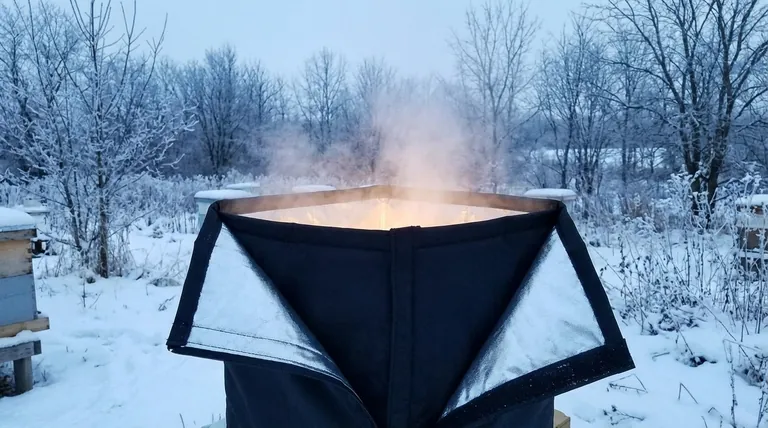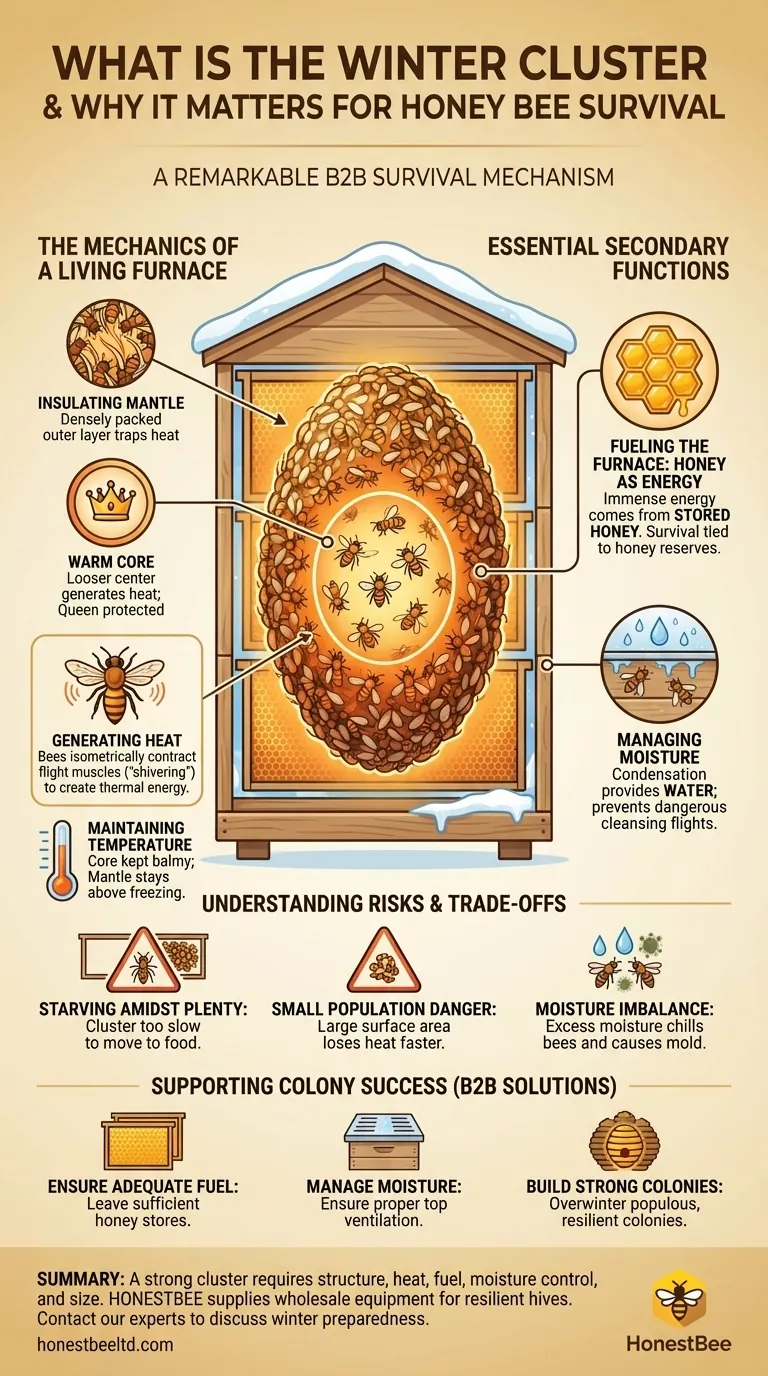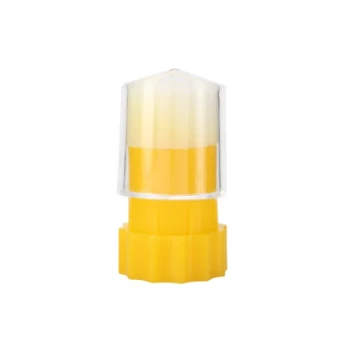The winter cluster is a remarkable survival mechanism that allows a honey bee colony to endure the freezing temperatures of winter. It is a tightly formed, rugby ball-shaped mass of bees that works as a living furnace, generating and conserving heat to protect the colony and, most importantly, the queen at its center. This collective behavior is the colony's single most important strategy for surviving a long, cold season.
The winter cluster is far more than a simple huddle for warmth. It is a highly organized, self-regulating system that enables honey bees to control their micro-environment, manage energy consumption, and ensure the queen survives to restart the colony in spring.

The Mechanics of a Living Furnace
The formation and maintenance of the winter cluster is a masterclass in collective thermoregulation. It is not a random pile of bees but a structured and dynamic entity.
The Structure: An Insulating Mantle and a Warm Core
The cluster consists of two main parts. The outer layer, or mantle, is a densely packed shell of bees, several inches thick, that acts as insulation. Bees on this outer edge are packed so tightly their body hairs interlace, trapping air and preventing heat from escaping.
The core of the cluster is much looser. Here, bees have room to move, tend to the queen, and actively generate heat. The queen is always located within this warm central area.
Generating Heat: The "Shivering" Bees
Individual bees inside the cluster's core generate heat by a remarkable process. They isometrically contract their powerful flight muscles without moving their wings.
This rapid vibration, or "shivering," converts chemical energy directly into thermal energy, actively heating the cluster's interior. As bees run out of energy or get cold, they move toward the warmer center, while others from the core cycle to the outer mantle.
Maintaining Temperature
The goal of the cluster is not to heat the entire hive, which would be an impossible waste of energy. Instead, it focuses on maintaining a stable temperature at its core.
The center of the cluster, where the queen resides, is kept at a relatively balmy temperature. The outer mantle's temperature can drop much lower, but it remains just above the point where bees would perish from cold.
More Than Just Heat: Essential Secondary Functions
While heat generation is the primary purpose of the cluster, this behavior serves other critical survival needs for a colony confined to the hive for months.
Fueling the Furnace: Honey as Energy
The immense energy required to vibrate muscles and produce heat comes from one source: stored honey. Throughout the winter, the cluster slowly moves as a single unit across the frames of honeycomb, consuming honey as it goes.
A colony's winter survival is directly tied to the amount of honey it has stored. If they run out of this fuel, they cannot generate heat and will freeze.
Managing Moisture: A Source of Water
A byproduct of the bees' respiration is water vapor. In a cold hive, this warm, moist air rises and condenses into water droplets on the cold inner cover or hive walls.
Bees can then collect this condensation as a source of drinking water. This elegant solution prevents them from having to take dangerous "cleansing flights" in sub-freezing temperatures to find water.
Understanding the Trade-offs and Risks
The winter cluster is a brilliant strategy, but it is not without its vulnerabilities. Understanding these risks is key to helping a colony survive.
Starving Amidst Plenty
The cluster is slow to move, especially in extreme cold. It is possible for the bees to consume all the honey within their immediate reach and starve to death, even with full frames of honey just inches away.
This is why the hive's food configuration is so important. Beekeepers must ensure honey is stored above and adjacent to the area where the cluster will likely form.
The Danger of a Small Population
The effectiveness of the cluster is directly related to its size. A small cluster has a larger surface area relative to its volume, meaning it loses heat much more quickly.
Small or weak colonies struggle to generate enough heat and have a much harder time surviving a long, cold winter.
Moisture Imbalance
While some condensation provides drinking water, excessive moisture is deadly. If ventilation is poor, water can drip down onto the cluster, chilling the bees, promoting mold, and stressing the colony.
Supporting Your Colony's Winter Success
A beekeeper’s role in winter is not to interfere with the cluster but to ensure the colony has what it needs to execute its own survival plan.
- If your primary focus is ensuring adequate fuel: Leave the colony with sufficient honey stores to last the entire winter, as this is the direct energy source for heat generation.
- If your primary focus is managing moisture: Ensure your hive has proper top ventilation to allow excess water vapor to escape without creating a cold draft on the bees.
- If your primary focus is colony strength: Only overwinter strong, populous colonies, as a larger mass of bees creates a more stable and resilient winter cluster.
By understanding the intricate dynamics of the winter cluster, you can better support this incredible natural process and ensure your colonies emerge strong in the spring.
Summary Table:
| Key Aspect | Importance for Survival |
|---|---|
| Structure | Insulating mantle protects a warm core where the queen is safe. |
| Heat Generation | Bees shiver flight muscles to generate life-sustaining warmth. |
| Fuel Source | Stored honey is the critical energy source for heat production. |
| Moisture Management | Condensation provides water; excess moisture is a major risk. |
| Colony Size | A large, populous cluster is more efficient and resilient. |
Ensure your apiary is equipped for winter success. A strong colony starts with the right supplies. HONESTBEE supplies commercial apiaries and beekeeping equipment distributors with the durable, wholesale-focused equipment needed to build resilient hives. From insulated hive bodies to essential feeding supplements, we provide the tools that support the natural brilliance of the winter cluster. Contact our experts today to discuss your winter preparedness strategy and secure your wholesale order.
Visual Guide

Related Products
- Professional Insulated Winter Hive Wrap for Beekeeping
- Heavy-Duty Stainless Steel Clip-On Frame Perch
- Long Langstroth Style Horizontal Top Bar Hive for Wholesale
- Professional Engraved Round Hive Number Tags for Beekeeping
- Professional Dual-End Stainless Steel Hive Tool for Beekeeping
People Also Ask
- What are the benefits of insulated beehives in cold weather? Boost Winter Survival & Spring Productivity
- Should bee hives be insulated? Protect Your Colony from Moisture, Not Just Cold
- What are the durability features of Bee Blankets? Built to Last in Demanding Apiary Conditions
- What are the steps to properly wrap a beehive for winter? Ensure Your Colony Survives the Cold
- How does insulation help bee hives in severely cold weather? Conserve Energy & Ensure Colony Survival



















